Ah, Stinging Nettles!
That pesky plant that seems to be in every garden, no matter how well groomed it is. If you’re looking for a way to permanently get rid of them, and do it naturally, then you’re in the right place.
Want your Nettles gone?
3 quick ways to kill Nettles.
- #1 - Pull them out, the easiest and cheapest way is to grab yourself a pair of gloves and yank those Nettles from the ground (make sure you get the roots!)
- #2 - Use a strong weed killer (this one works on Nettles). Just spray it over your Nettles and they'll die, no hard work or effort required.
- #3 - Try Mulching over it! Deprive those stinging monsters of light and they will die. It'll also enhance your soil. Cardboard is a natural way to kill your PESKY nettles.
Identifying Stinging Nettles
Recognising Urtica Dioica
Stinging nettles, scientifically known as Urtica dioica, are distinguishable by their unique features.
- Leaves: The leaves are typically pointed at the tips and serrated along the edges. They are heart-shaped or lanceolate and grow in opposite pairs.
- Stems: Covered with tiny hairs, the stems are upright and can cause a stinging sensation when touched.
- Flowers: Stinging nettle flowers are tiny and greenish-white in colour, hanging in clusters from the leaf axils.
This plant can grow up to four feet tall in nutrient-rich soil.
Understanding the Growth Habit
Stinging nettles are resilient and can spread quickly if not managed.
- They thrive in a wide range of soil types, but prefer moist and fertile ground.
- Nettles often appear in areas that have been left uncultivated or disturbed.
By recognising stinging nettles with confidence, you're a step closer to effective control and management in your garden or outdoor space.
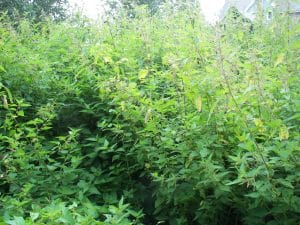
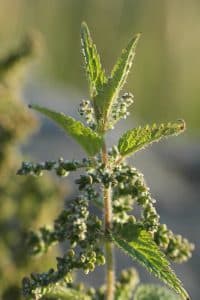
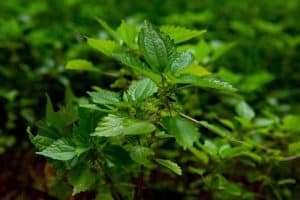
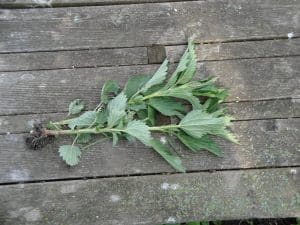
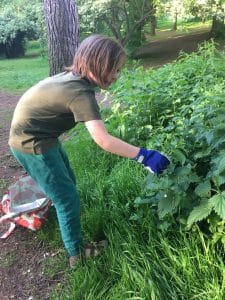
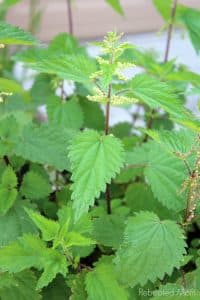
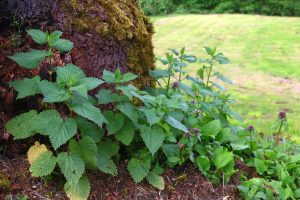
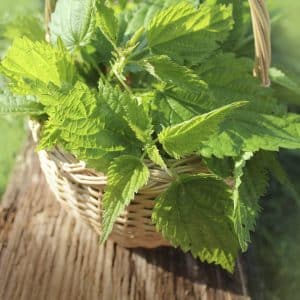
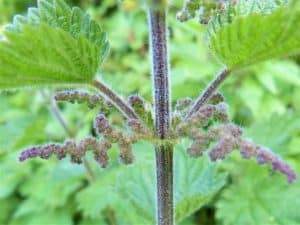


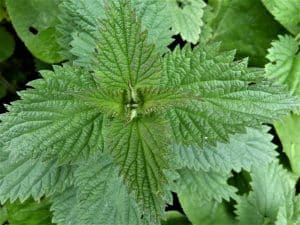

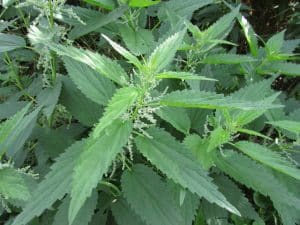
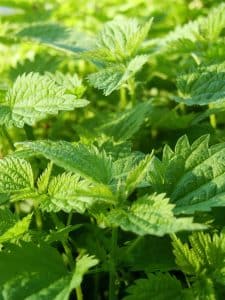
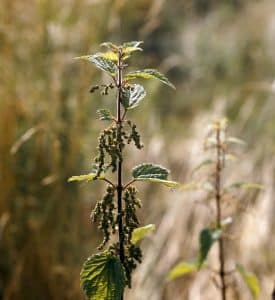
Essential Tools and Safety Equipment

Equipping yourself with the correct tools and safety equipment is crucial when tackling stinging nettles in your garden.
Selecting the Right Gloves
Your hands are the first point of contact with stinging nettles, so selecting the right gloves is vital. Choose gloves that are thick and durable, preferably made of a robust material like leather. They should cover your wrists to provide maximum protection.
Choosing Appropriate Garden Tools
For the actual removal of stinging nettles, you'll require a few key garden tools:
- Hoe or Spade: A sharp hoe can be used to slice through the base of the nettles, while a spade is ideal for digging out the roots.
- Garden Fork: For larger areas, use a garden fork to loosen the soil and remove the shallow creeping roots more effectively. It's important that the fork is sturdy to handle the torque required to uplift the roots.
Always ensure your equipment is well-maintained to avoid unnecessary strain or injury.
Organic Control Methods
Implementing organic methods to control stinging nettles ensures that you're not harming the environment or non-target plants and animals. By using these techniques, you contribute to ecological balance while effectively managing these invasive weeds.

Manual Removal Techniques
Preparation: Before you begin, wear thick gardening gloves to protect your hands from the nettles' sting.
- Young Nettles: For young plants, grip firmly at the base and pull upward to remove the entire root.
- Established Nettles: With mature clumps, use a garden fork to loosen the soil around the roots. Gently remove the entire root system to prevent regrowth.
Tip: Regularly remove young nettles before they establish to reduce your workload over time.
Organic Mulching Solutions
Utilising mulch effectively suppresses nettle growth.
- Application: Cover the soil with a generous layer of organic mulch, about 10-15 cm deep.
- Materials: Use organic materials like straw, wood chips, or compost from your compost heap to enrich the soil as they decompose.
Benefit: This barrier prevents sunlight from reaching the nettle seeds, inhibiting their germination.
Making Use of Natural Predators
Stinging nettles are part of a balanced ecosystem, attracting beneficial predators.
- Ladybirds: Host to aphids, nettles attract ladybirds, which feed on these pests, aiding in your garden's pest control.
- Birds: Dense nettle patches can provide nesting sites for birds, which in turn feed on insects that may otherwise damage your crops.
Maintaining Balance: If nettles are not problematic, consider allowing a few to grow in an out-of-the-way area to support wildlife.
Chemical Control Methods

When dealing with stinging nettles, chemical control often provides a reliable solution. The choice of herbicide and the application technique are crucial for effectiveness.
Choosing the Right Herbicides
The most effective chemical solution for nettles is a systemic weedkiller. These are absorbed by the plants and transported to the root system. Look for products containing glyphosate, which is a common and potent ingredient in systemic weedkillers. Glyphosate-based herbicides, like Roundup, are widely recommended due to their ability to kill nettles down to the root. It is important, however, to select a herbicide that is appropriate for your specific situation and follow the label instructions carefully.
Applying Systemic Weedkillers
Proper application is key to successfully using systemic weed killers. Here are the steps you should follow:
- Timing: Apply the weedkiller in early spring when nettles start to emerge, or during summer after cutting back the nettles and allowing some regrowth.
- Method: Spray the herbicide directly onto the nettles, ensuring thorough coverage without affecting nearby desirable plants.
- Safety: Always wear protective clothing, such as gloves and long sleeves, and follow the safety instructions on the herbicide label.
Remember that multiple applications may be necessary, especially for larger infestations. Keep children and pets away from treated areas until the herbicide has dried completely.

Cultivation Techniques to Prevent Regrowth
In your battle against stinging nettles, it's imperative to employ cultivation methods that hinder their ability to regrow. Attentive hoeing, tilling, and mowing can be instrumental in your efforts, provided they're carried out with consistency and focus on disrupting the plant's regrowth cycle.
Hoeing and Tilling Strategies
You can significantly reduce nettle regrowth through regular hoeing and tilling of your soil. Aim to disturb the nettles during their active growing phase in spring and early summer.
- Hoe shallowly to sever the nettles from their roots, avoiding deep cultivation that can bury seeds, leading to future germination.
- Till the soil when preparing cultivated ground for planting, breaking up nettles' root systems.
By incorporating hoeing into your routine, you stand a better chance at keeping nettles at bay and preventing their spread.
Effective Mowing Practices
Mowing can help manage nettles, provided it's performed frequently and at the right stage of the weed's growth.
- Mow the area as nettles reach a height of about 8-10 cm to weaken their growth.
- Regular mowing deprives the nettles of the chance to build up the energy reserves they need to regrow.
Do remember to collect and dispose of the clippings to prevent nettles from propagating through pieces of spread stems or rhizomes. Repeat mowing will gradually reduce the vigour of the nettles and help you maintain soil and garden health free from these persistent weeds.
Addressing Nettle Seed Spread
Effectively preventing the spread of stinging nettle is crucial to control this invasive weed. Specifically, you need to focus on containing and eliminating the seedlings and curtailing seed dispersal to manage the population.
Controlling Nettle Seedlings
When aiming to control stinging nettle, early intervention is key. You should remove young nettle plants and seedlings from freshly cultivated soil before they have a chance to establish. This is best done by hand-pulling while they are still small, as this method allows you to get most of the roots out of the ground.
- Be prepared: Always wear gloves to protect against stings.
- Regular inspection: Search for and remove new seedlings, particularly after disturbing the soil in gardens and allotments.
- Deep digging: For established seedlings, dig deep to remove as much of the root system as possible, preventing further growth.
Minimising Seed Dispersal
To limit the spread of stinging nettles, it is essential to prevent their seeds from maturing and dispersing.
- Flower removal: Pinch out the flowers of stinging nettles as soon as they appear. This action stops the plants from going to seed.
- Cut back before seeding: If you notice plants that have begun to form seeds, cut these nettles back immediately to prevent the seeds from maturing and spreading around your garden or into wild areas.
- Consider beneficial wildlife: If you maintain nettles to attract wildlife, such as butterflies, control the seeding by selectively removing flowering tips.
By following these specific actions, you can significantly reduce the spread of stinging nettles through seeds.
Timing and Seasonal Considerations
Effective control of stinging nettles (Urtica dioica) requires strategic timing, particularly during the seasons when they actively grow and die down. By understanding when new shoots emerge, you can take preventative measures to ensure nettles do not become a recurring problem in your garden.
Tackling Nettles in Spring
In spring, stinging nettles begin their growth cycle, with new shoots emerging from the ground. This is the ideal time to target these invasives as they are vulnerable. A judicious application of systemic weedkiller to these shoots can be quite effective, ensuring the herbicide is absorbed into the plant's system, resulting in a thorough kill. Remember to reapply as necessary when fresh growth appears.
- Early Spring:
- Action: Apply weedkiller to young shoots.
- Goal: Prevent establishment and spread of nettles.
Managing Nettle Growth Through Summer
By summer, nettles are often fully established, making them harder to manage. If nettles are not treated in spring, you'll have to deal with mature plants in summer which may require cutting down before applying treatments. The cut-down foliage should be treated with a systemic weedkiller on the regrowth that follows. Throughout the summer, nettles may die down and regrow; hence, vigilance is required to treat any new shoots promptly.
- Summer:
- Action: Cut down and apply weedkiller to regrowth.
- Goal: Eliminate mature plants and prevent regrowth of new nettles.
Understanding the Ecological Impact
Before commencing control measures against stinging nettles in your garden, it's crucial to acknowledge their ecological significance. Recognising the complex interplay between stinging nettles and local wildlife will help inform a balanced approach to nettles in your green space.
Recognising the Benefits for Wildlife
Stinging nettles (Urtica dioica) serve as a vital food source and habitat for various wildlife species. They are especially significant for numerous butterfly species, including the striking Red Admiral. The nettles provide essential larval food plants for these butterflies. With this in mind, a total eradication of stinging nettles may not be the ecologically responsible choice.
- Butterflies: Particularly caterpillars of the Red Admiral and other species rely on nettles.
- Ladybirds: Find shelter and aphids, their primary food source, among nettles.
- Aphids: These pests are attracted to nettles but also serve as food for beneficial insects like ladybirds.
Balancing Control with Conservation
Your approach to nettles should strive for balance; removing nettles from key areas while conserving them in less-utilised sections of your garden can prove beneficial for both your needs and local ecosystems.
- Garden Zones: Leave nettles undisturbed in areas where you’ve noticed wildlife activity.
- Control: Limit spreading by cutting nettles back before they seed, avoiding chemical treatments near wildlife-visited areas.
By understanding the role of stinging nettles in supporting wildlife, you can manage these plants in a way that benefits both your garden's aesthetics and its biodiversity.
Disposal of Removed Nettles
Once you have successfully removed stinging nettles from your garden, it is important to dispose of them properly to prevent regrowth and to adhere to safety guidelines.
Composting Stinging Nettles
You can add the foliage and stem parts of stinging nettles to your home compost heap. To ensure the nettles decompose without the risk of regrowing, follow these steps:
- Chop up the foliage and stems to accelerate the breakdown process.
- Do not include the roots in the compost heap, as they may take root again if the compost doesn't reach high enough temperatures.
By composting nettles, you'll be recycling the plants back into nutrients for your garden.
Safe Burning Practices
If you choose to burn the removed nettles, you must do so responsibly:
- Check local regulations: Before you start, ensure you comply with local bylaws regarding outdoor burning.
- Choose a safe location: Burn nettles in a clear area, away from structures and trees.
- Monitor the fire: Stay with the fire until it is completely extinguished to prevent the risk of spreading.
Burning provides a quick way to dispose of nettles, but always prioritise safety and legality.
Differentiating Types of Nettles
Before attempting to manage stinging nettles, it's crucial to differentiate between types as treatment may vary. Familiarise yourself with whether you're dealing with perennial or annual varieties and recognise subspecies variations.
Identifying Perennial vs. Annual Nettles
Perennial stinging nettles (Urtica dioica) tend to have a persistent presence due to their hardy rhizomes, which spread underground. You can identify them through their heart-shaped leaves and clusters of small, greenish flowers. They return every year and can create larger patches if not controlled.
In contrast, annual nettles (Urtica urens) are more temporary, completing their life cycle within a single year. Although similar in appearance, they're generally smaller and their presence indicates soil that has been disturbed. They spread through abundant seeds rather than rhizomes.
Recognising Subspecies Variations
While identifying subspecies of nettles might not be necessary for eradication purposes, it’s useful for understanding the plant’s characteristics. Variations can occur in leaf shape, plant size, and the persistence of sting.
- Urtica dioica subsp. dioica: Commonly found across the UK, noted for its broad leaves.
- Urtica dioica subsp. galeopsifolia: Typically has narrower leaves and is less common.
When assessing your nettles, note such variations as they might give clues on the best approach for eradication and the ecological importance of the plants in your area. Remember, nettles can be beneficial for certain wildlife, including some butterfly species.
Alternative Uses for Stinging Nettles
Beyond their pesky stings, nettles can be quite useful in certain preparations that might surprise you, notably in creating nourishing teas and potent fertilisers.
Creating Nettle Tea and Liquid Fertiliser
Nettle tea is a nutrient-rich drink made from the leaves of stinging nettles. This beverage has been traditionally consumed for its myriad of health benefits, including anti-inflammatory properties. To make stinging nettle tea:
- Harvest nettle leaves, ideally with gloves to avoid stings.
- Rinse the leaves thoroughly to remove any dirt or bugs.
- Add the leaves to boiling water and let them steep for 10 to 15 minutes.
- Strain the tea and enjoy it hot, or cool it for a refreshing drink.
Stinging nettles can also be used to make a liquid fertiliser, which is beneficial for plants requiring rich nutrients. Here’s a simple method to create your own:
- Submerge a bundle of nettles in a bucket of water, weighing them down to keep them submerged.
- Cover the bucket to prevent evaporation and leave the nettles to steep for a few weeks.
- Once the liquid turns dark and the plant material has decomposed, strain it to obtain your fertiliser.
- Dilute the liquid with water at a 10:1 ratio (water) before applying it to your plants’ soil.
Utilising Nettles in Organic Gardening
Nettles can be an asset in organic gardening. When included in a compost heap, nettles act as a natural accelerator due to the high nitrogen content of their leaves. Chop the nettles finely before adding them to the compost to enhance their decomposition rate and to facilitate quicker nutrient release.
Additionally, nettles can form part of a natural pest control regimen in your garden. Nettle-based sprays can deter pests, and nettles themselves can attract beneficial insects, such as ladybirds, which feed on common garden pests like aphids.

Frequently Asked Questions
When dealing with stinging nettles in your garden, certain methods have proven to be more effective than others. This section addresses some common queries about the eradication of stinging nettles.
What methods are most effective for eradication of stinging nettles in gardens?
To eradicate stinging nettles, it is often recommended to combine physical removal with chemical treatments. Digging out the roots and applying a systemic weedkiller containing glyphosate can be very effective. Repeated treatments may be necessary to completely remove nettles.
Can household vinegar be used to control nettles, and if so, how?
Yes, household vinegar can be used as a natural herbicide on nettles. Applying vinegar directly to nettles during a sunny day can help to kill them, but be cautious as vinegar might affect soil pH and other nearby plants.
Is it possible to eliminate stinging nettles using natural remedies?
There are several natural remedies that can help manage stinging nettle infestations. Methods include repeated cutting to deplete the roots, covering with tarpaulin to block sunlight, and applying mulch. However, these methods may be more time-consuming compared to chemical treatments.
Does the application of boiling water ensure the destruction of stinging nettle plants?
Pouring boiling water on nettles is a quick, natural way to kill them. However, you may need to apply boiling water multiple times to permanently eliminate the plants as this method doesn't always kill the root system.
What are the most suitable sprays to deploy against stinging nettles?
For chemical control, sprays containing glyphosate are common and effective against nettles. Weedkillers with the active ingredient Vitax SBK can also be successful. Always follow the label instructions for safe and efficient use.
Can salt be employed as a reliable herbicide for stinging nettles?
While salt may kill nettles, its use as a herbicide is not recommended. Salt can greatly damage the soil structure, harm beneficial organisms, and make the soil unsuitable for future plant growth. Use salt with extreme caution, if at all, as a herbicide.

Hi there,
I have cut down my stinging nettles and am interested to know how long do they retain their sting after being cut down?
A few days, I would advise you wear gloves as there is no exact time frame, a lot depends on environmental factors
When using boiling water to kill stinging nettle how long will it take to kill them
IT won’t kill them but it will stun them, effects are almost instantaneous